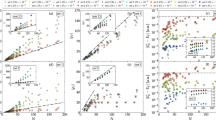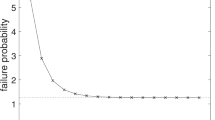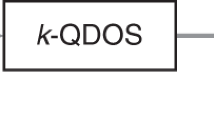Abstract
We describe an algorithm that computes the ground state energy and correlation functions for 2-local Hamiltonians in which interactions between qubits are weak compared to single-qubit terms. The running time of the algorithm is polynomial in n and δ−1, where n is the number of qubits, and δ is the required precision. Specifically, we consider Hamiltonians of the form \({H=H_0+ \epsilon V}\) , where H 0 describes non-interacting qubits, V is a perturbation that involves arbitrary two-qubit interactions on a graph of bounded degree, and \({\epsilon}\) is a small parameter. The algorithm works if \({|\epsilon|}\) is below a certain threshold value \({\epsilon_0}\) that depends only upon the spectral gap of H 0, the maximal degree of the graph, and the maximal norm of the two-qubit interactions. The main technical ingredient of the algorithm is a generalized Kirkwood-Thomas ansatz for the ground state. The parameters of the ansatz are computed using perturbative expansions in powers of \({\epsilon}\) . Our algorithm is closely related to the coupled cluster method used in quantum chemistry.
Similar content being viewed by others
References
Kempe J., Kitaev A., Regev O.: “The Complexity of the Local Hamiltonian Problem”. SIAM J. Computing 35(5), 1070–1097 (2006)
Oliveira, R., Terhal, B.M.: “The complexity of quantum spin systems on a two-dimensional square lattice”. http://arXiv.org/list/0504050, 2005, to appear in Quant. Inf. Comput.
Kato T.: “Perturbation Theory for Linear Operators”. Springer-Verlag, New York (1966)
Yarotsky D.: “Perturbations of ground states in weakly interacting quantum spin systems”. J. Math. Phys. 45(6), 2134 (2004)
Osborne T.: “Simulating adiabatic evolution of gapped spin systems”. Phys. Rev. A 75, 032321 (2007)
Abrikosov A., Gorkov L., Dzyaloshinski I.: “Methods of Quantum Field Theory in Statistical Physics”. Dover Publications Inc., New York (1975)
Lindgren I.: “The Rayleigh-Schrödinger perturbation and the linked-diagram theorem for a multi-configurational model space”. J. Phys. B 7(18), 2441 (1974)
Kirkwood J., Thomas L.: “Expansions and Phase Transitions for the Ground State of Quantum Ising Lattice Systems”. Commun. Math. Phys. 88, 569–580 (1983)
Datta N., Kennedy T.: “Expansions for one quasiparticle states in spin 1/2 systems”. J. Stat. Phys. 108, 373 (2002)
Lang S.: “Complex Analysis”. Graduate Texts in Mathematics 103. Springer-Verlag, New York (1985)
Anderson P.W.: “Infrared Catastrophe in Fermi Gases with Local Scattering Potentials”. Phys. Rev. Lett. 18, 1049 (1967)
Verstraete F., Wolf M.M., Perez-Garcia D., Cirac J.I.: “Criticality, the area law, and the computational power of PEPS”. Phys. Rev. Lett. 96, 220601 (2006)
Coester F.: “Bound states of a many-particle system”. Nucl. Phys. 7, 421 (1958)
Crawford T., Schaefer H.: “An Introduction to Coupled Cluster Theory for Computational Chemists”. Rev. Comput. Chem. 14, 33–36 (1999)
Farnell, D.J.J., Bishop, R.F.: “The Coupled Cluster Method Applied to the XXZ Model on the Square Lattice”. http://arXiv.org/list/cond-mat/0606060, 2006
Datta N., Fernández R., Fröhlich J.: “Low-temperature phase diagrams of quantum lattice systems. I. Stability for quantum perturbations of classical systems with finitely-many ground states”. J. Stat. Phys. 84, 455–534 (1996)
Borgs C., Kotecký R., Ueltschi D.: “Low temperature phase diagrams for quantum perturbations of classical spin systems”. Commun. Math. Phys. 181, 409–446 (1996)
Hastings M., Koma T.: “Spectral Gap and Exponential Decay of Correlations”. Commun. Math. Phys. 265, 781 (2006)
Bravyi S., Hastings M., Verstraete F.: “Lieb-Robinson bounds and the generation of correlations and topological quantum order”. Phys. Rev. Lett. 97, 050401 (2006)
Latorre J.I., Rico E., Vidal G.: “Ground state entanglement in quantum spin chains”. Quant. Inf. Comput. 4, 48 (2004)
Bravyi, S., DiVincenzo, D.P., Loss, D., Terhal, B.M.: “Simulation of Many-Body Hamiltonians using Perturbation Theory with Bounded-Strength Interactions”. http://arXiv.org/abs/0803.2686, 2008
Bhatia R.: “Matrix Analysis”. Graduate Texts in Mathematics 169. Springer-Verlag, New York (1997)
Aliferis P., Gottesman D., Preskill J.: “Accuracy threshold for postselected quantum computation”. Quant. Inf. Comput. 8, 181 (2008)
Author information
Authors and Affiliations
Corresponding author
Additional information
Communicated by M.B. Ruskai
Rights and permissions
About this article
Cite this article
Bravyi, S., DiVincenzo, D. & Loss, D. Polynomial-Time Algorithm for Simulation of Weakly Interacting Quantum Spin Systems. Commun. Math. Phys. 284, 481–507 (2008). https://doi.org/10.1007/s00220-008-0574-6
Received:
Accepted:
Published:
Issue Date:
DOI: https://doi.org/10.1007/s00220-008-0574-6




